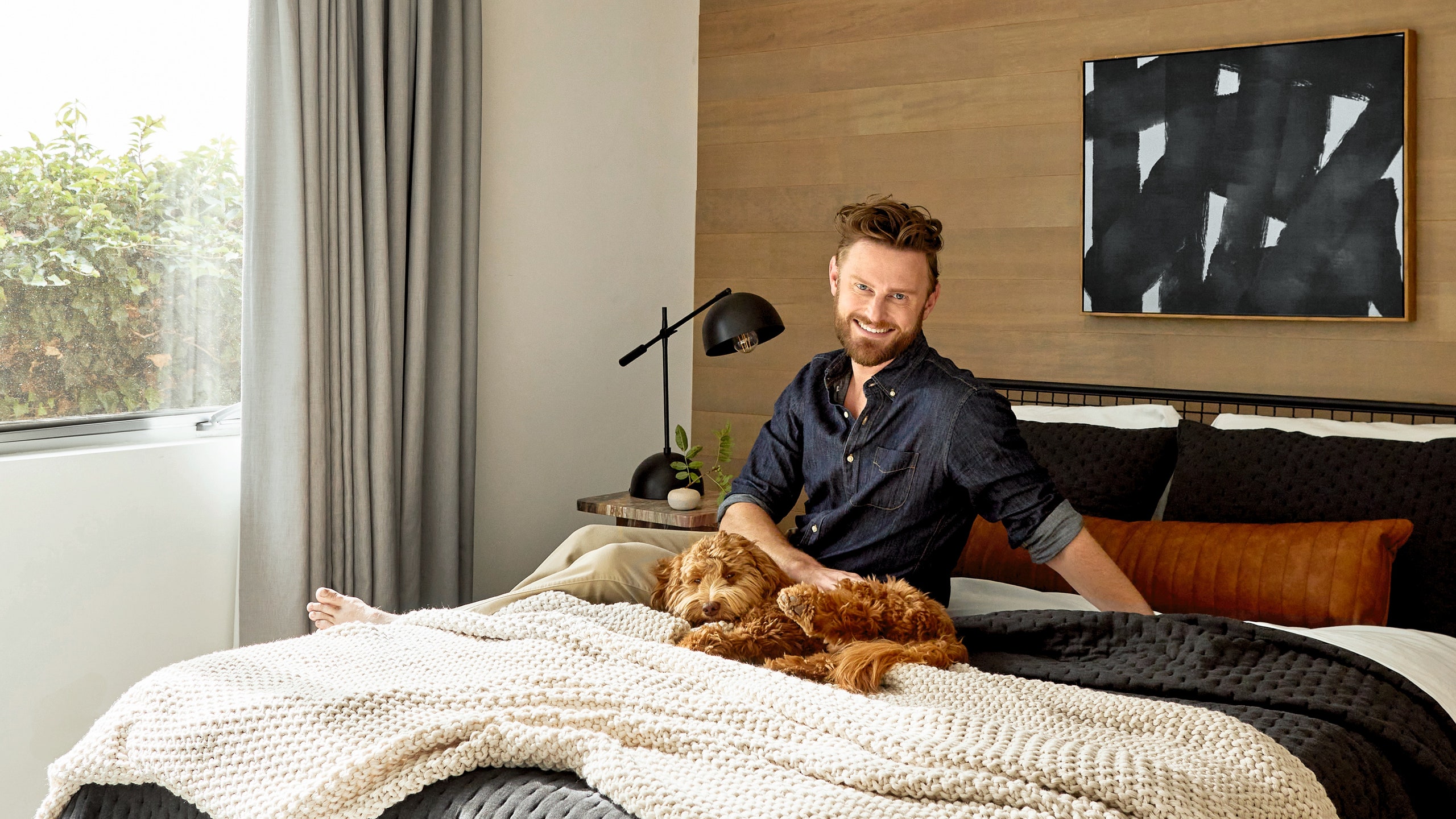In Bobby Berk’s forthcoming book, Right at Home: How Good Design Is Good for the Mind (written with Jamie Park), the Queer Eye star explores the connection between good design and mental health. Going room by room, the self-taught interior decorator shares his tips and tricks for creating the functional, cozy, space of your dreams. And speaking of dreams, Berk has shared an exclusive excerpt from the pages of Right at Home with AD ahead of the book’s September 12 release. Read on for his tried and true tips for creating the perfect sleep sanctuary in your own home.
Okay, so let’s be real. Smartphones kind of own us now, making “turning off” pretty much impossible. But the act of carving out time to prepare for sleep—a crucial, restorative activity for your mind and body—is key (and the operative phrase here is “prepare for”). Here’s why: When it comes to habits, your neurons are wired to love repetition, so when it comes to building a nightly routine, the way you plan out your wind-down process will, in time, become super automatic. Whether it’s dimming the lights, lighting a candle, or setting out your pajamas on your bed—whatever that step 1 is for you, start to build an association and be consistent. Soon, you’ll notice your mind and body will begin to “rewire” itself. Your nightly wind-down will become as Pavlovian as brushing your teeth at night.
More and more research is uncovering how insanely vital sleep is for your mental and physical health. Not getting at least seven to eight hours a night messes with your hormone levels, affecting everything from appetite to mood to memory. In fact, there was a study done that showed improving your sleep patterns had more of a measurable, positive effect on people diagnosed with depression than some antidepressants did! (Yep, that’s how powerful sleep is.) Good sleep also starts way before you get into bed. Here’s a cheat sheet I like to use for eliminating things that might disrupt my sleep:
Cut off caffeine six hours before bed; alcohol four hours before bed; large meals, three hours; nicotine, two hours; and strenuous exercise, one and a half hours before bed.
Day: In addition to getting regular sunlight, some studies show that watching the sunrise IRL is a healthy way to get your vitamin D. The mix of reddish lightwaves (infrared) with the blue light (the good kind!) is fantastic for your health, including your mood
Night: Chill out your lights at night. Bright light in the evenings (including blue light) can prevent the natural release of melatonin (the hormone that starts up your body’s natural sleep program). Incandescents, warmer temp LEDs, and even candles are all fair game.
Your body temperature naturally lowers before and during sleep to conserve energy, so it’s important to keep your bedroom cooler during the night to help facilitate this (65 degrees Fahrenheit is the sweet spot). Higher core body temperatures not only increase the chances of you waking up in the middle of the night but also have been linked to less restorative, slow wave/REM sleep overall. Luckily, there are lots of ways to help cue your body temperature to start cooling off.
COOL YOUR BODY: Take a lukewarm shower. Drink cold water. Wear breathable pajamas.
COOL THE BED: Choose breathable fabrics. Skip the flat sheet. Choose a bed frame lower to the ground.
COOL THE ROOM: Use insulated curtains/window treatments. Create airflow using a fan or an open window. Turn off all devices(electronics that are plugged in produce heat).
When it comes to the bedroom, my advice is to always keep things as simple as possible. You want to be cognizant of what’s in your line of sight, especially in a room that should be tailored to help you shut down. Now, that’s not to say your bedroom should be boring or plain (remember, your design style is whatever makes you happy!), but there are ways of styling this very personal space that keep your personality intact while optimizing for a good night’s sleep. The nightstand in particular is a bedroom workhorse that is prone to becoming a major clutter magnet—it’s just way too easy to start piling stuff onto it, so make sure to lean toward keeping it minimal, tidy, and clutter-free.
While I have my personal favorite bedroom colors based on color psychology (remember how strongly I felt about those blue curtains in my childhood bedroom!), I totally get that color is a really personal thing. For example, even though red isn’t my first recommendation because it’s prone to increase your heart rate (something you DON’T want when you’re trying to sleep), I’ve found ways of toning it down to promote ultimate relaxation.
If you’re not naturally a good sleeper or go through phases where it’s tougher than normal, it’s worth looking into a few extras to give you an assist.
ANALOG ALARM: Avoid LED lights by the bed with a classic clock (just make sure it’s dead silent).
EXTRA SEATING: Don’t stay in bed if you struggle with insomnia. It’s important to keep the sleep/bed association sacred so that you associate being in bed only with sleeping. If more than twenty minutes go by while you’re awake, get out of bed, sit in another area, and do something else relaxing (read, meditate) until you get sleepy again.
AROMATHERAPY: Eucalyptus and lavender have been shown to help calm the nervous system.
WEIGHTED TEXTILES: Studies have shown that the extra pressure helps lower your heart rate and slow down breathing when you’re anxious.
Right at Home: How Good Design Is Good for the Mind by Bobby Berk (with Jamie Park) is available to pre-order now. It hits booksellers September 12.
